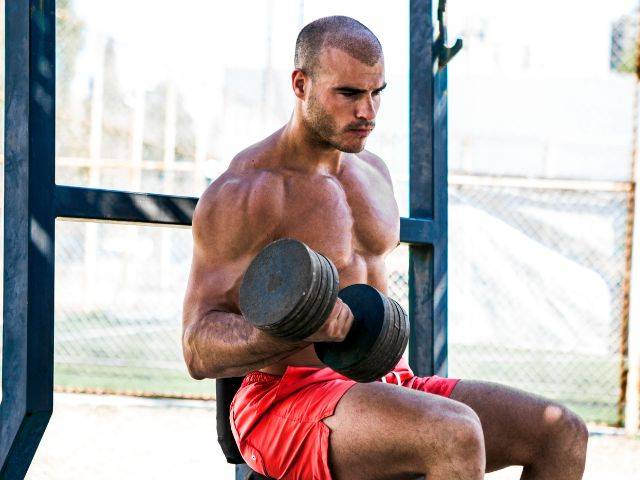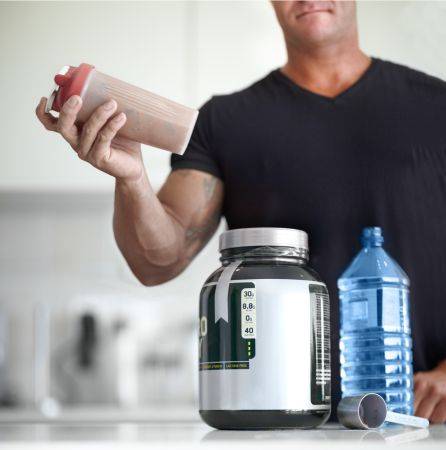
Gaining muscle is a goal that many want to achieve. Whether for strength, aesthetics, or health reasons, understanding how to gain muscle is paramount.
In this article we cover important proven tips, and you’ll be well on your way to building a muscular physique.
Proven Ways On How To Gain Muscle
- Prioritize Strength Training
Ditch the endless hours on the treadmill and step into the weight room.
Focusing on weight training with compound exercises, like those that engage multiple muscle groups simultaneously. This helps muscle growth.
Exercises like squats, deadlifts, pull ups, shoulder presses and bench presses are your best friends here.
Forget the forearm curls and isolation exercises like bicep concentration curls. Do big compound movements that will maximize muscle activation, giving you more bang for your buck in the gym.

- Progressive Overload
Ever heard the saying, “What doesn’t challenge you, won’t change you”? It’s precisely the case with muscle growth.
To see continuous muscle development, you must gradually increase weight, intensity or resistance. This principle ensures that muscles don’t become complacent but are always pushed to grow and adapt.
Add one more rep or an extra pound on the barbell, concentrate on progressive overload.
- Manage Caloric Intake

This muscle gaining tip is key. You need to be in a calorie surplus, or a positive energy balance to gain weight.
Building muscle isn’t just about protein; you need extra overall calories to fuel this growth.
While the source of these calories doesn’t really matter for short term, for long term health it does. Eat a wide range of meats, diary, legumes, fish, fruits and wholegrains, etc. Also choose nutrient-dense foods that provide vitamins and minerals like vegetables.
Having extra food and calories is not an invitation to binge on just junk. But rather to consume a well-balanced diet that supports muscle growth without excessive fat gain.
See also – CICO For Weight Loss: The Most Important Concept To Know!
How To Gain Muscle As A Skinny Guy
- Eat Protein-Rich Foods
As part of being in a caloric surplus, get enough protein as well.
Muscles like protein. This macronutrient aids in repairing muscle fibers torn during workouts, making way for bigger, stronger muscles.
Aim for meats like chicken, beef and fish, dairy products like milk, eggs, and legumes.
Supplement with protein powder if it suits your preferences.
See also – High Protein Foods To Buy
- Get Ample Rest
It might sound counterintuitive, but resting is just as vital as lifting. Especially if we are doing big heavy compound movements like squats.
It’s during those precious hours of sleep that our body busily repairs and rebuilds muscles.
For optimal muscle growth, aim for a solid 7-9 hours of sleep every night. Even more if you are a growing teenager.
- Stay Hydrated
Muscles, believe it or not, thrive on water. Water aids in various metabolic reactions essential for muscle growth and keeps the muscles, organs, and brain healthy.
So, grab that water bottle and make it your constant companion.
- Mind-Muscle Connection

When working out, it’s essential to be mentally present. Control the weight, don’t let it bounce around. If it is, lighten the weight and go a bit slower and control the weight.
By concentrating on the muscle you’re exercising, you can activate more muscle fibers, leading to better results. It’s not just about moving the weight, but about feeling and focusing on every contraction.
With some muscle groups like the biceps and with certain exercises, this connection is easier to feel.
Warmups are a great way to not only get into the groove physically, but also mentally.
- Limit Cardio
Cardio is fantastic for heart health and burning calories, but when overdone, it can hinder muscle growth. The trick lies in finding the perfect balance.
Mix some light occasional cardio in with your strength training routine for best results.
- Consistency is Key
Like any worthy goal, gaining muscle isn’t a one-time effort but a consistent journey.
Stay dedicated to your workout and nutrition plan, tweak as necessary based on feedback and results, and keep the end goal in mind.
Being consistent in your workouts is more important than doing the best exercise for your biceps. After all if you only go to the gym now and then, it won’t make as much as an impact on your biceps as being consistent.
- Most Supplements Are a Waste of Money
Stop buying the latest supplements for muscle mass gains and save your money. Most supplements don’t work for the price you pay.
The ones that might have some very small benefit for muscle growth are normally under-dosed as well.
(I am not talking about protein supplementation. Use protein powder if you like though if it fits your preference.)

Eat enough calories, get enough protein, do some weights and you are good to go.
Optional – Creatine is one supplement that has plenty of proven scientific research and can help with strength training and muscle mass.
- Sets and Reps
Try and train major muscle groups around two times a week.
For beginners, perform around 5 to 6 sets per muscle group per workout. So in a total week you are doing around 10 to 12 sets for each body part.
As an example for chest, you do 5 sets on Monday and 5 sets on Thursday.
For advanced lifters you might need more sets, especially for complicated body parts like the back.
Your reps might be around the 7 to 12 range.
This will depend on the exercise and body part, but generally stick around those rep ranges. It might even range from 5 reps to 15 repetitions, depending on exercise selection and muscle group.
For deadlifts you might just do 5 reps, at the other end of the spectrum, for calves, you might do 15 to 20 reps.
- Workout Routines

They are plenty of muscle building routines out there, but some popular ones are:
Upper body / Lower body split. That is, you concentrate on your upper body one weight training session, then the next work your lower body.
You might do the Upper body / Lower body split, three to four times a week.
Another program is Push / Pull / Legs. In the push workout you work your chest, shoulders and triceps. The pull session is back and biceps. The legs is quads, glutes, hamstrings and calves.
Whole body training is another routine, where you might go to the gym, three times a week and training the whole body. You are doing less sets per body part but you are training three times a week.
Switch it up to suit your lifestyle and try to train muscle groups around two times a week, maybe three for some body parts.
- The Big Picture: Tying All The Elements Together
Concentrate on the big things that do work. Like being in a caloric surplus, getting enough protein and sleep, doing big compound movements.
Be consistent going to the gym and try and improve each time (progressive overload) and you will gain muscle.
Remember, the journey to gaining muscle is personal, and what works for one person might not work for another. But with these tips, you are concentrating on important factors that will help you build muscle fast. You are not wasting time on small things that don’t make much of an impact in muscle growth.
FAQs
Here are some common FAQs in relation to gaining muscle:
How long does it take to see noticeable muscle growth?
Typically, with consistent training and proper nutrition, one might start seeing visible changes in muscle size in as little as 3, 4-6 weeks. However, significant muscle gains might take several months to many years or more.
How much protein should I consume daily to support muscle growth?
While individual needs can vary, a general recommendation is to consume between 0.5 to 0.8 grams per pound of body weight per day (1.2-1.7 grams of protein per kilogram of body weight.)
Aim towards the higher end if you are training hard and you’re engaged in regular strength training.
Do I need to take supplements to gain muscle?
While a balanced diet should ideally provide all the necessary nutrients, some individuals benefit from protein powders, or creatine.
Protein powders and protein bars are convenient.
What’s the difference between strength training and hypertrophy training?
Strength training focuses on increasing one’s ability to lift heavier weights, usually with lower reps (like 1-5 reps per set).
Hypertrophy training aims specifically at increasing muscle size and involves higher reps (typically 8-15) with a more moderate weight.
Can I gain muscle without lifting weights?
Yes, bodyweight exercises like push-ups, pull-ups, dips, and body squats can help build muscle. However, to continue seeing growth, one must constantly find ways to challenge the muscles, such as increasing repetitions or modifying exercises to make them harder, like using bands.
To get bigger though, you need to lift weights.
Why am I gaining weight but not seeing muscle definition?
It’s possible you’re gaining both muscle and fat. This might be due to consuming too many calories or not incorporating enough cardiovascular activity.
It’s essential to monitor nutrition and maintain a balance between calories in, and activity like strength training and cardio.
How important is the post-workout meal?

Post-workout nutrition plays a role. Consuming protein and carbohydrates post-workout can help muscle repair and glycogen storage. But more important is the overall daily calorie intake for muscle recovery and growth.
Do I need rest days, or can I train every day?
Rest days are vital. They allow muscles to recover, repair, and grow. Training a muscle group continuously without adequate rest can lead to over-training and even injury.
You might train 3 to 5 days a week. For beginners, 3 to 4 days a week would be suitable.
How can I ensure I’m practicing the mind-muscle connection properly?
Start with lighter weights and focus entirely on the contraction and relaxation of the muscle being worked. Visualization and controlled movements can enhance this connection.
Is cardio counterproductive to muscle gain?
Not necessarily for light cardio. While excessive cardio can burn the calories you need for muscle growth, a balanced amount of low impact, low intensity, can complement muscle building and improve overall fitness.
Conclusion
Understanding how to gain muscle is a combination of proper training, nutrition, rest, and dedication.
The journey might be challenging, but with these muscle building keys and proven tips, you’re armed with the knowledge to a stronger, more muscular version of yourself.
Embrace the process, enjoy your progress, and never lose sight of your muscle-gaining goals.
Resources and Extra Information
How to Get Big Biceps: Your Ultimate Guide
How To Gain Muscle Without Weights
What Is Energy Balance In Weight Loss?
Burn The Fat Feed The Muscle. By Tom Venuto.
The Renaissance Diet, A Scientific Approach to Getting Leaner and Building Muscle. By Dr. Mike Israetel, with Dr. Jen Case and Dr. James Hoffman.
The Muscle and Strength Nutrition Pyramid. By Eric Helms.
Specialist in Fitness Nutrition. John Berardi, PH.D and Ryan Andrews, MS/MA, RD.



